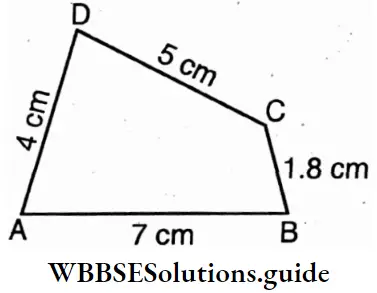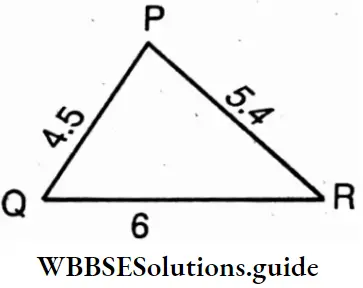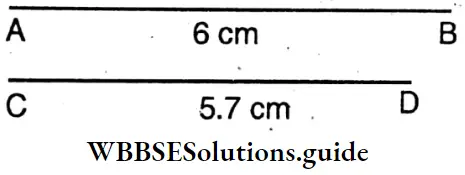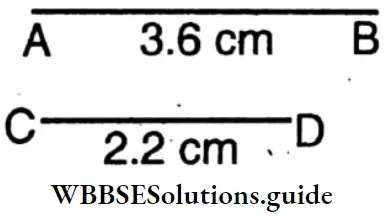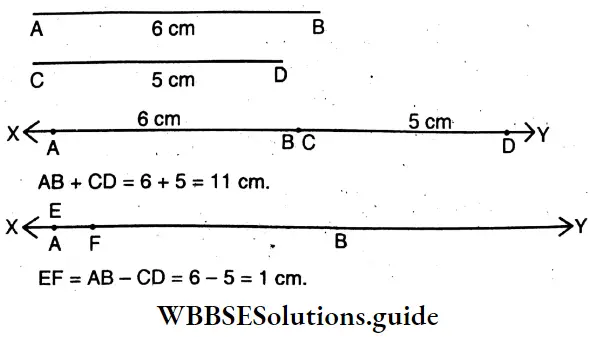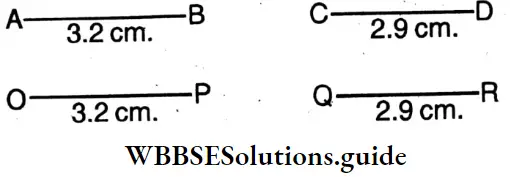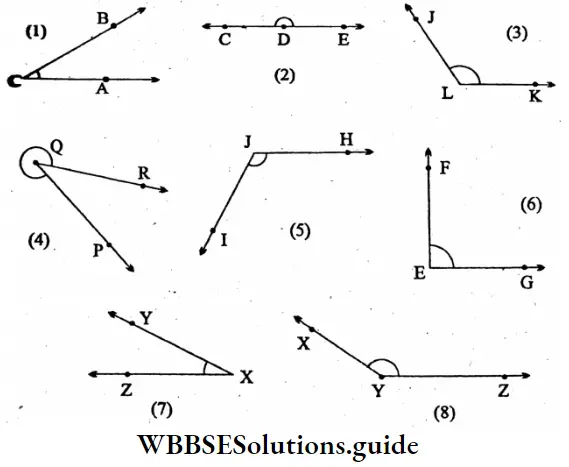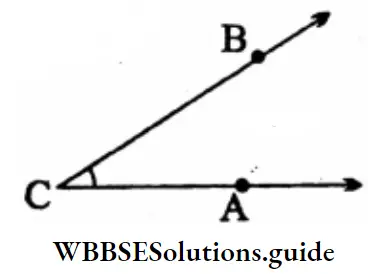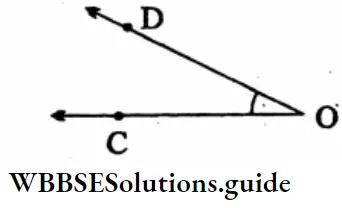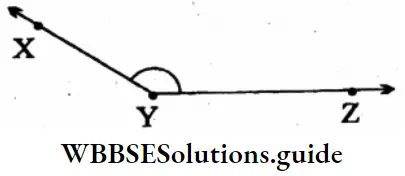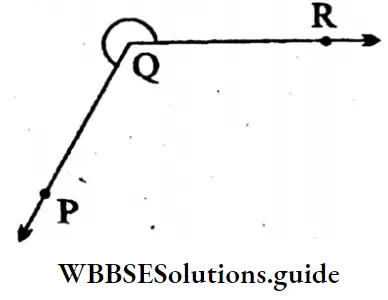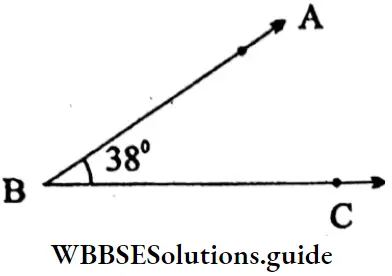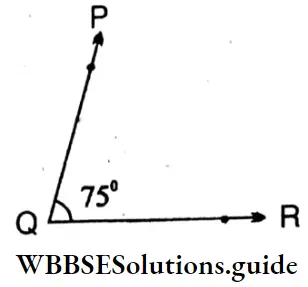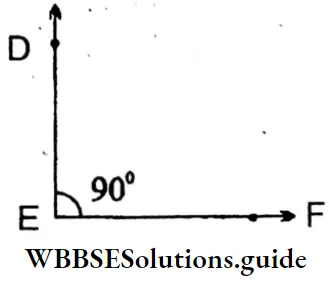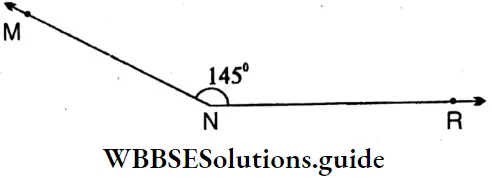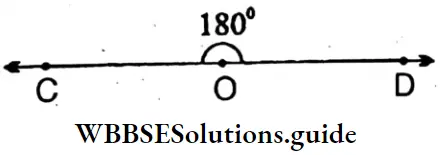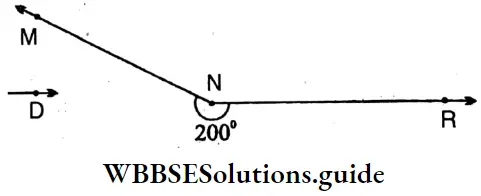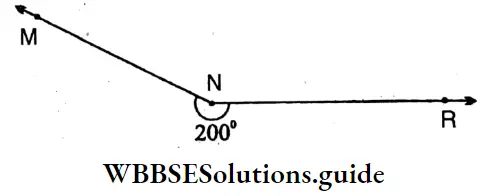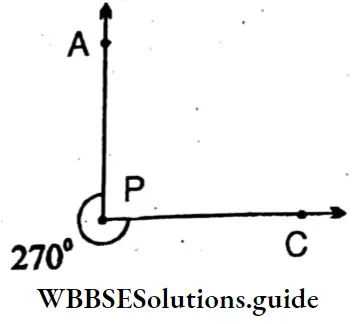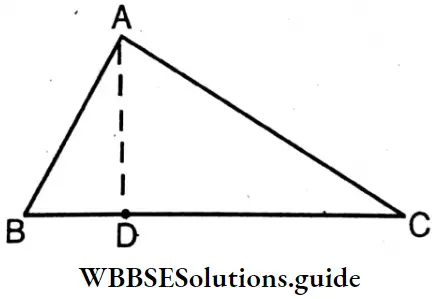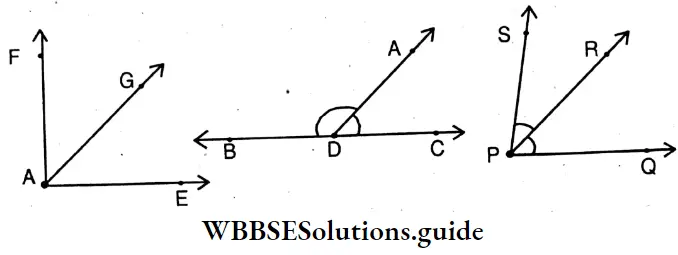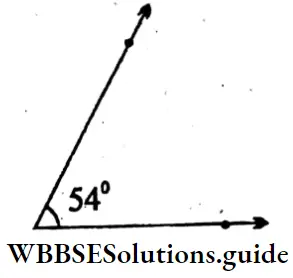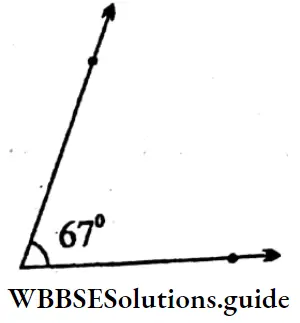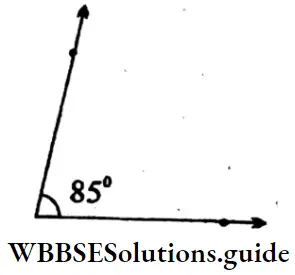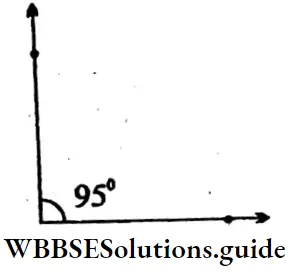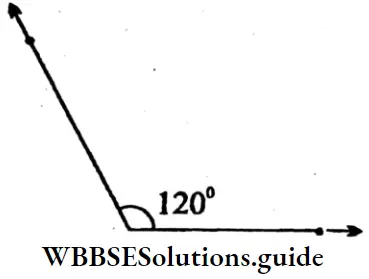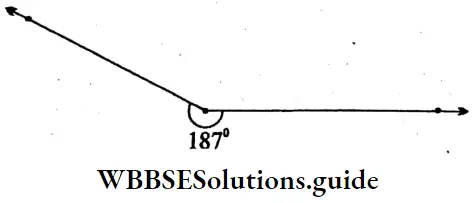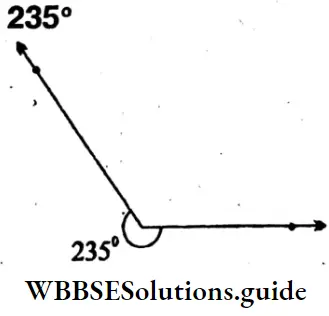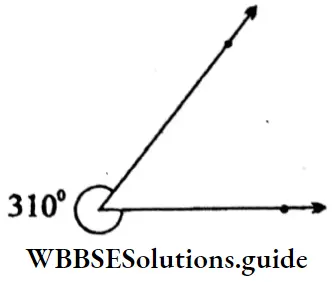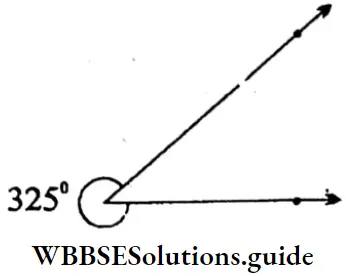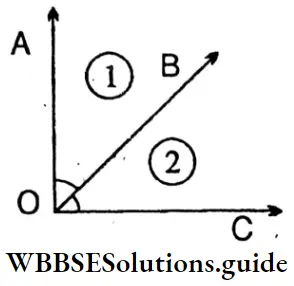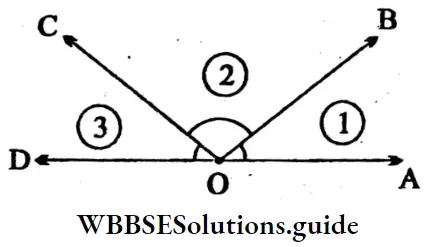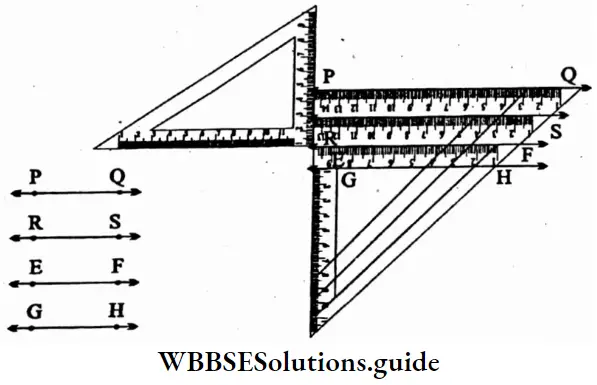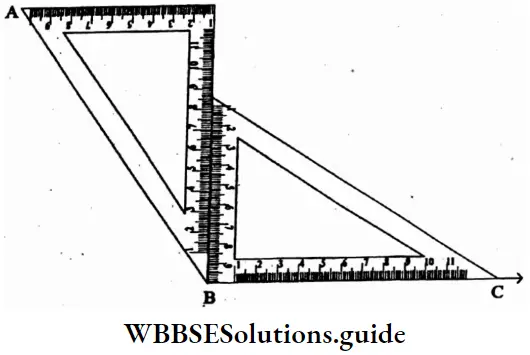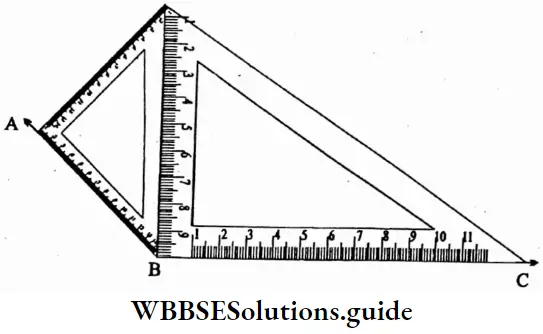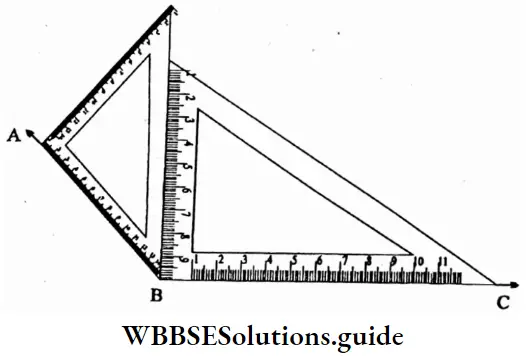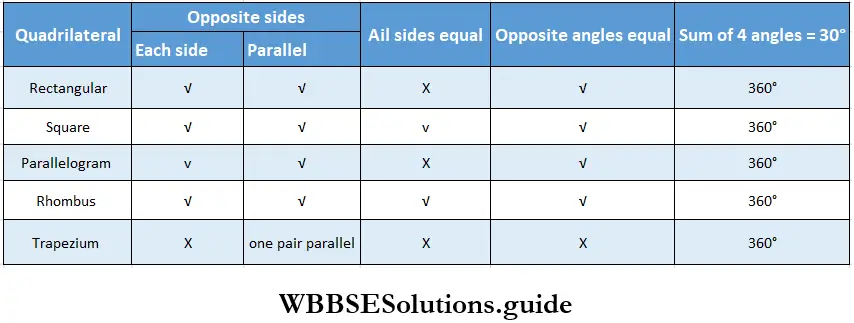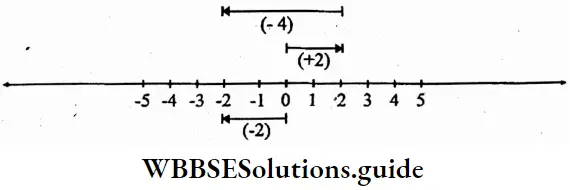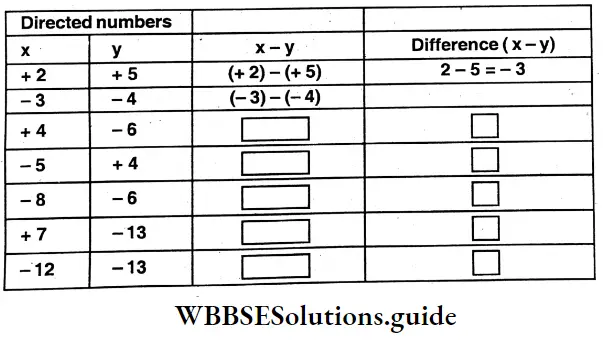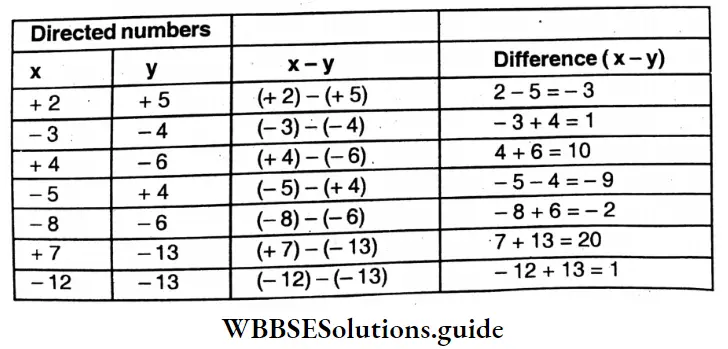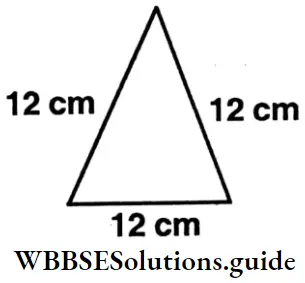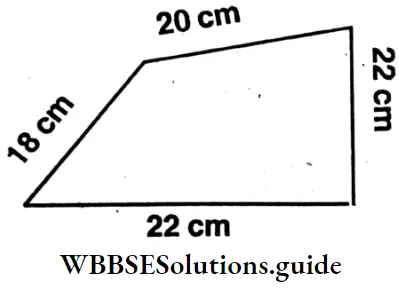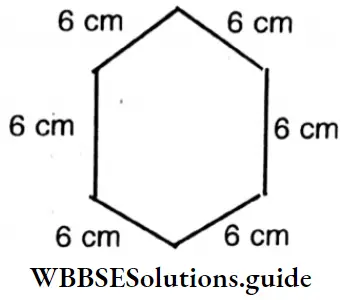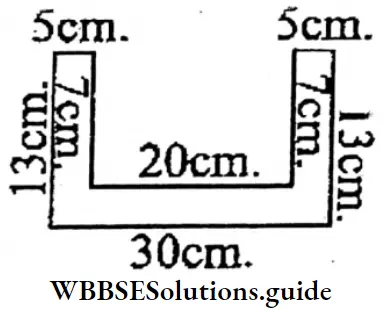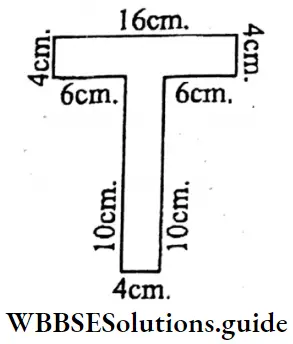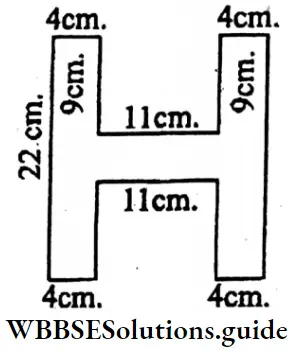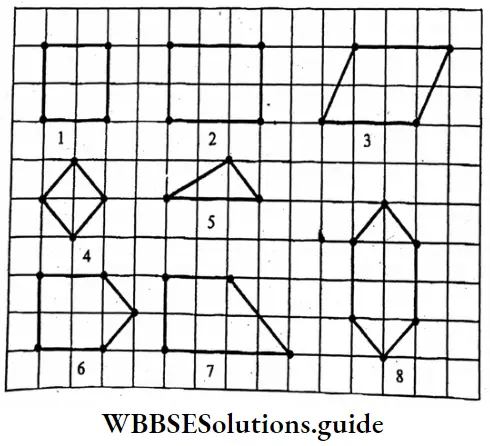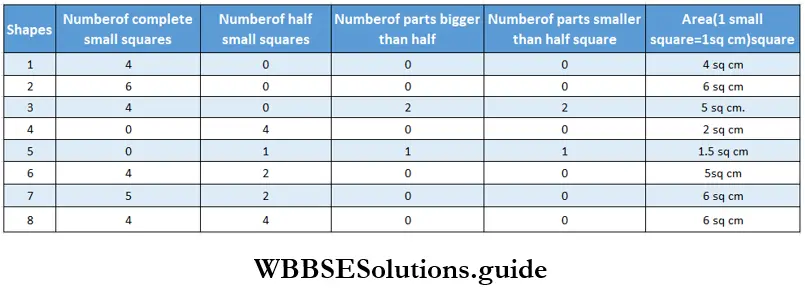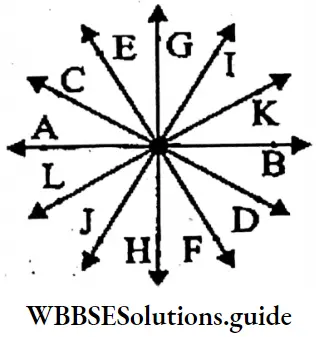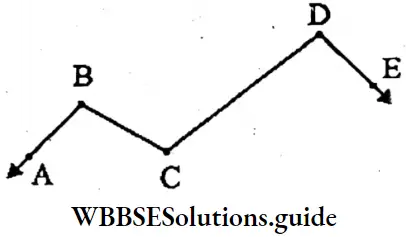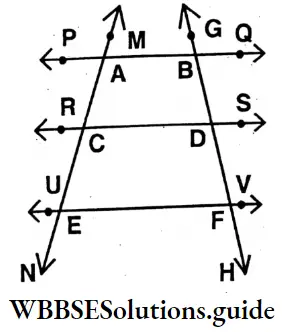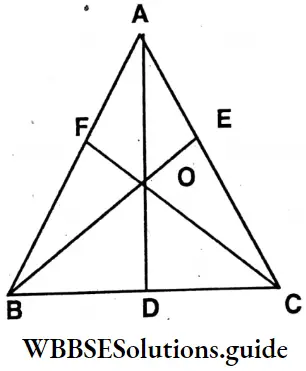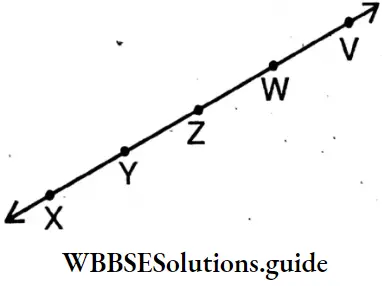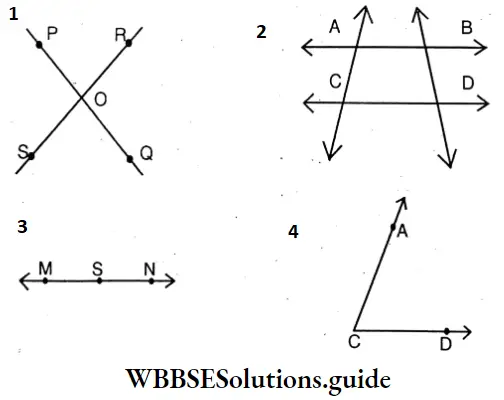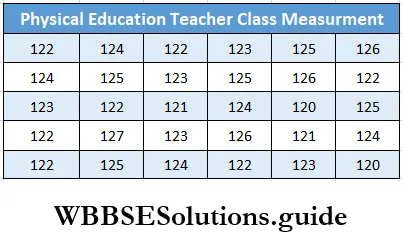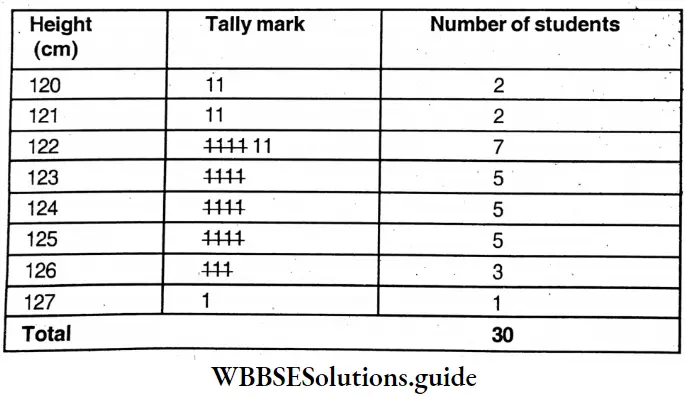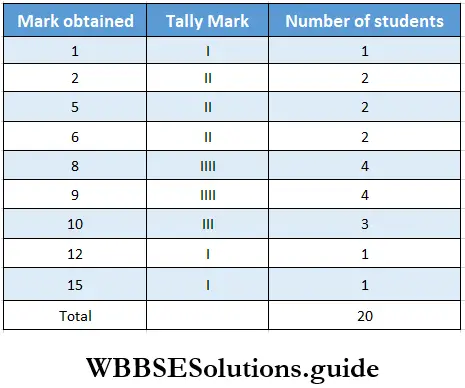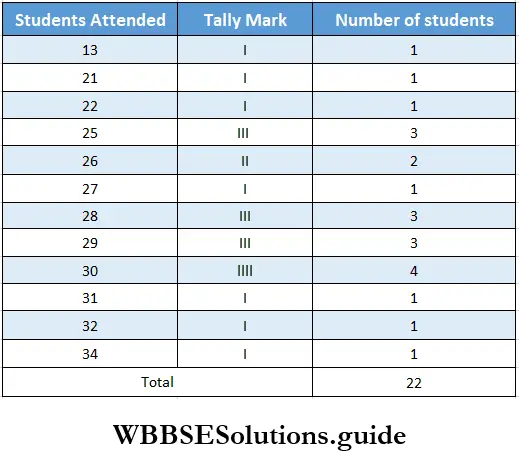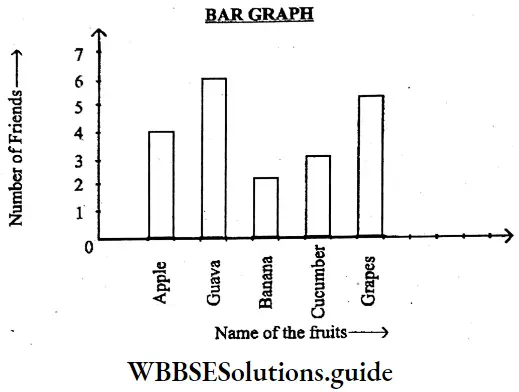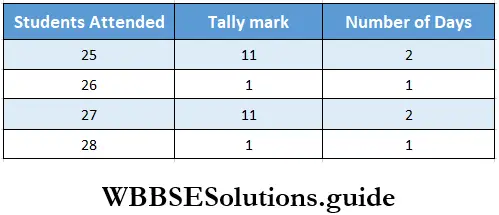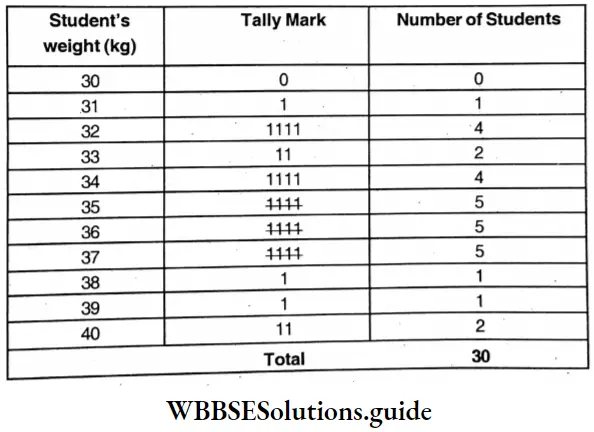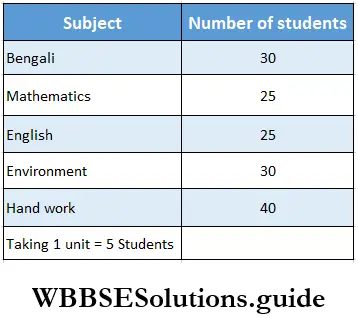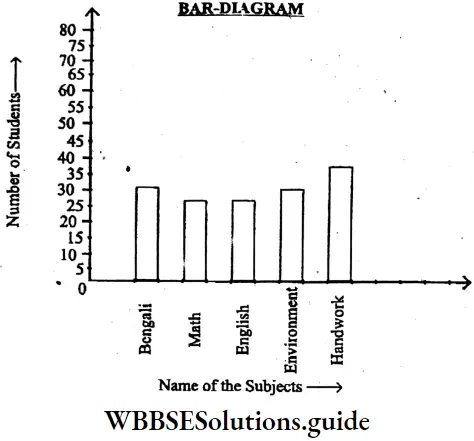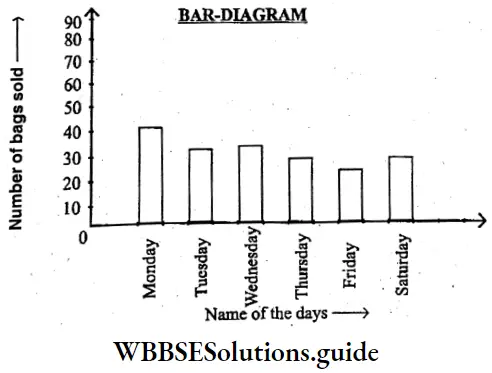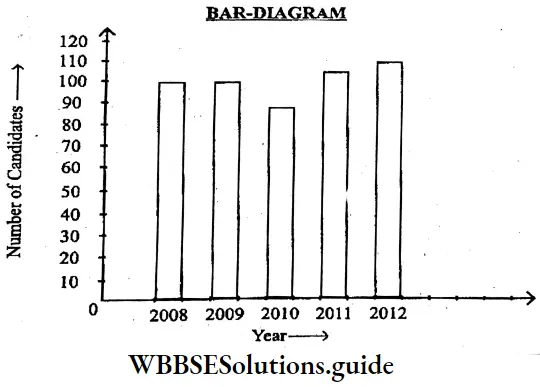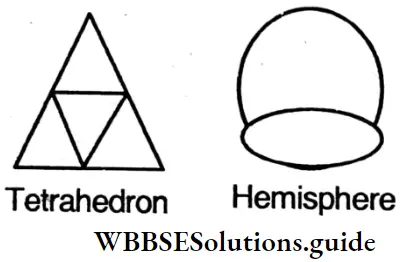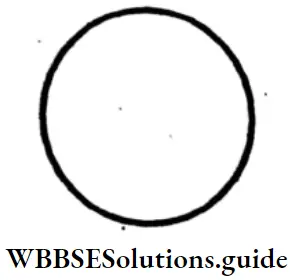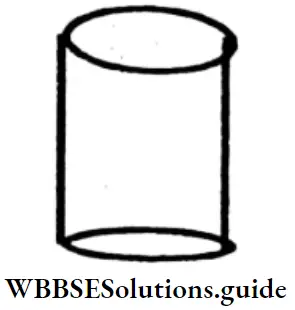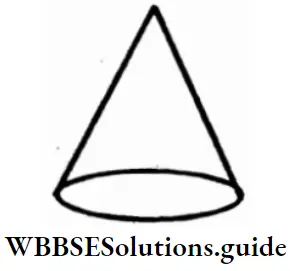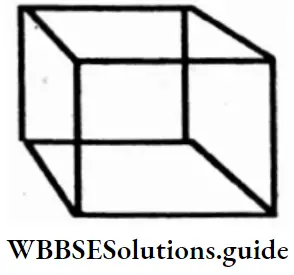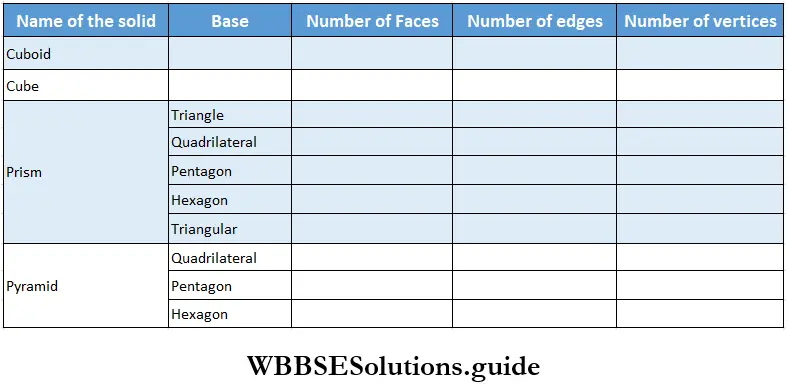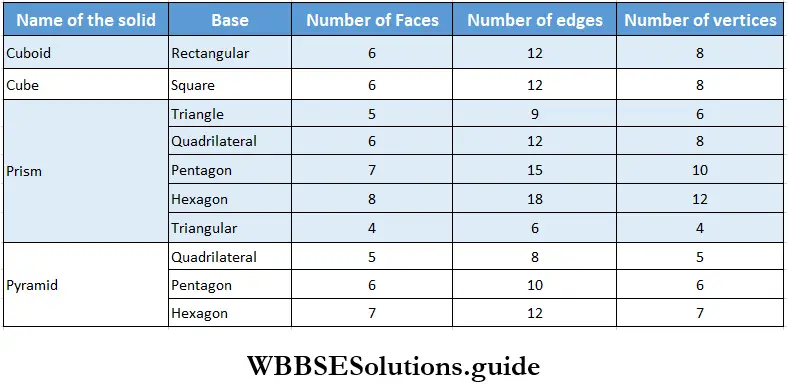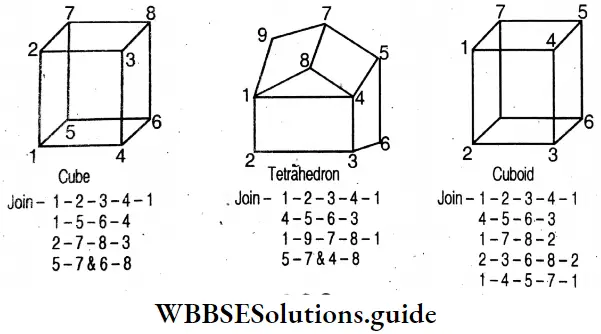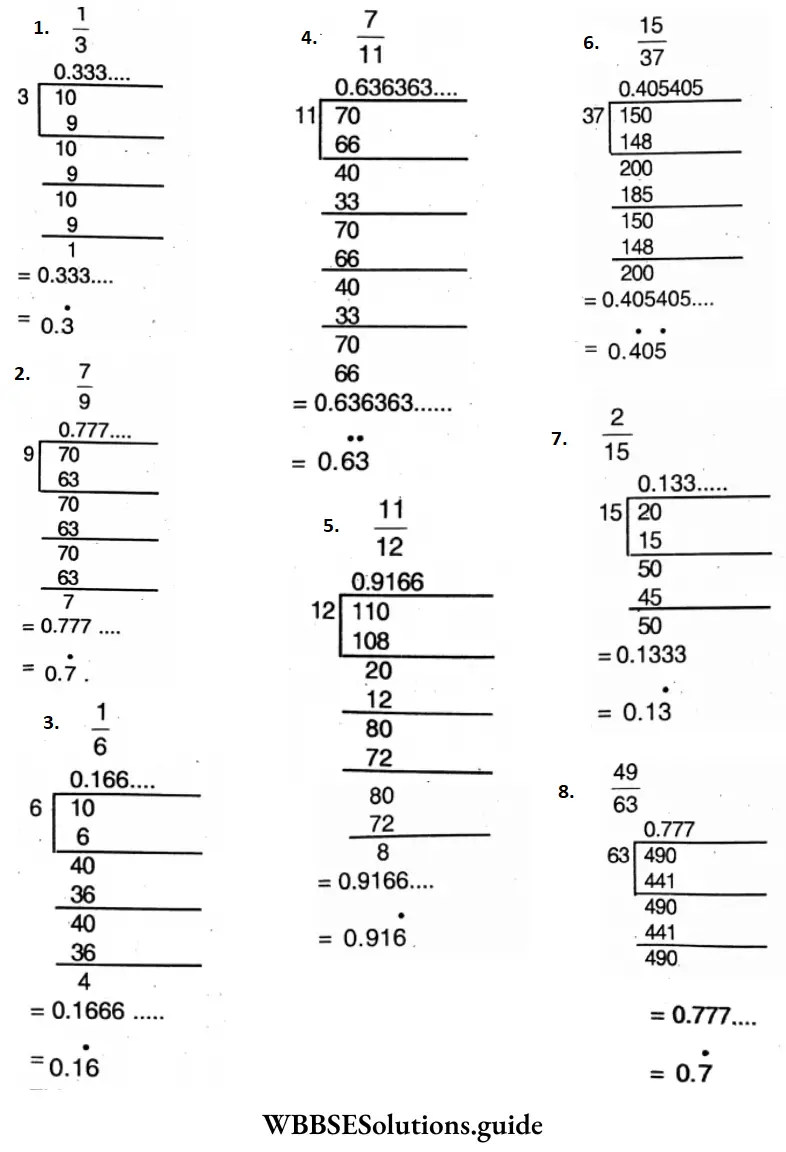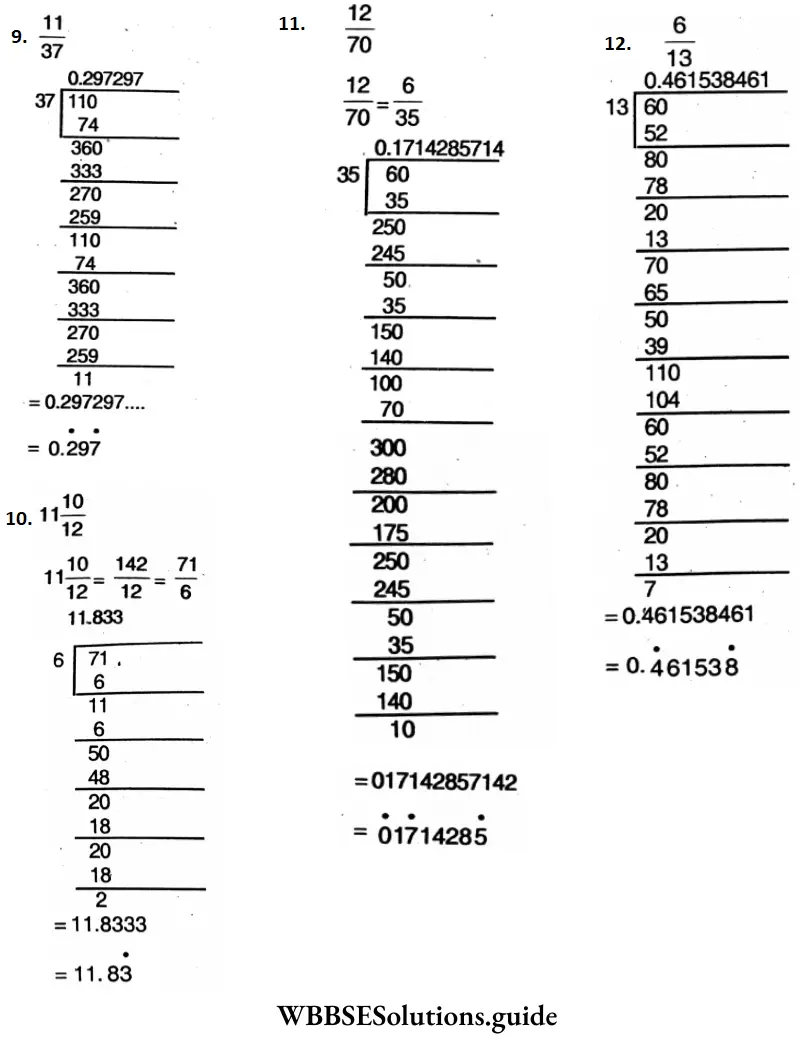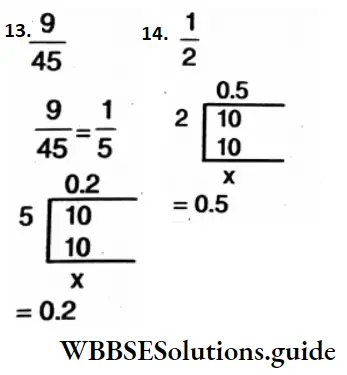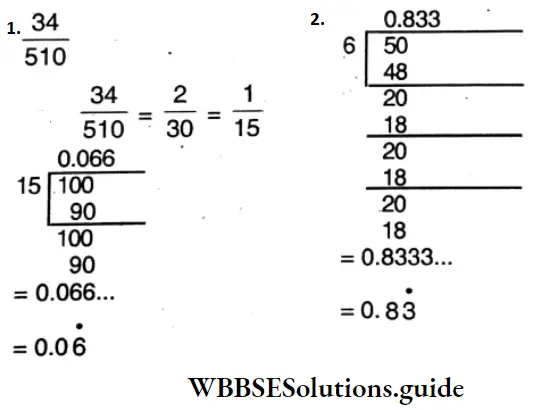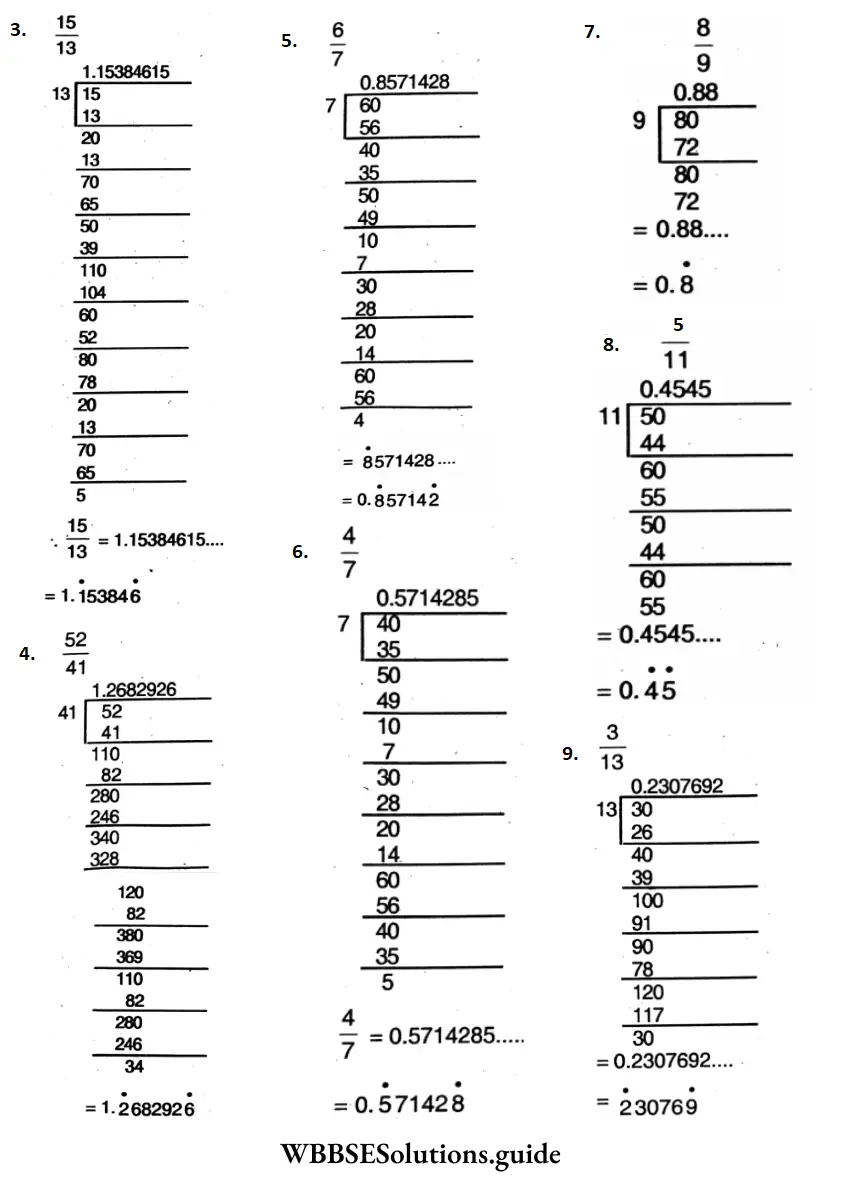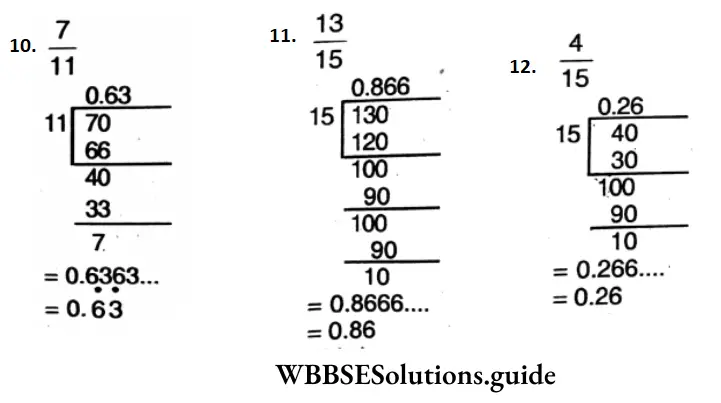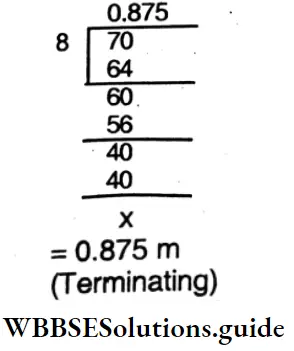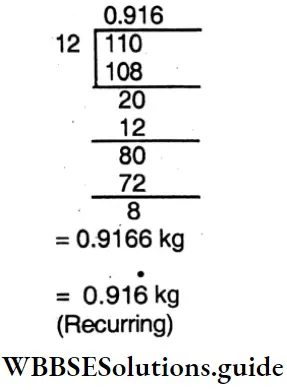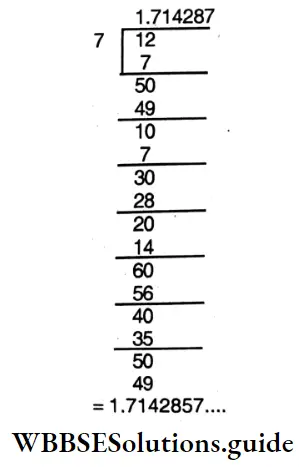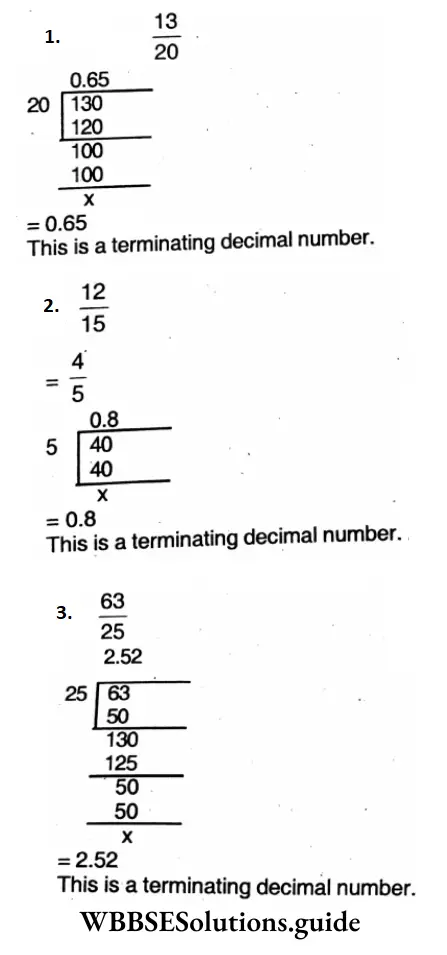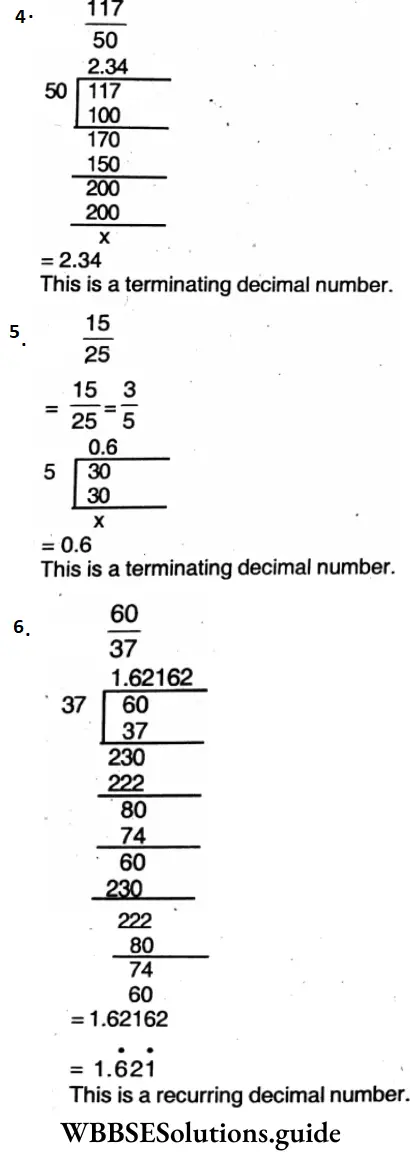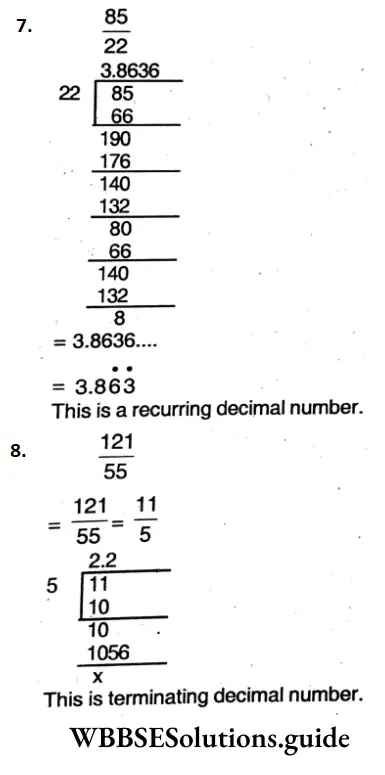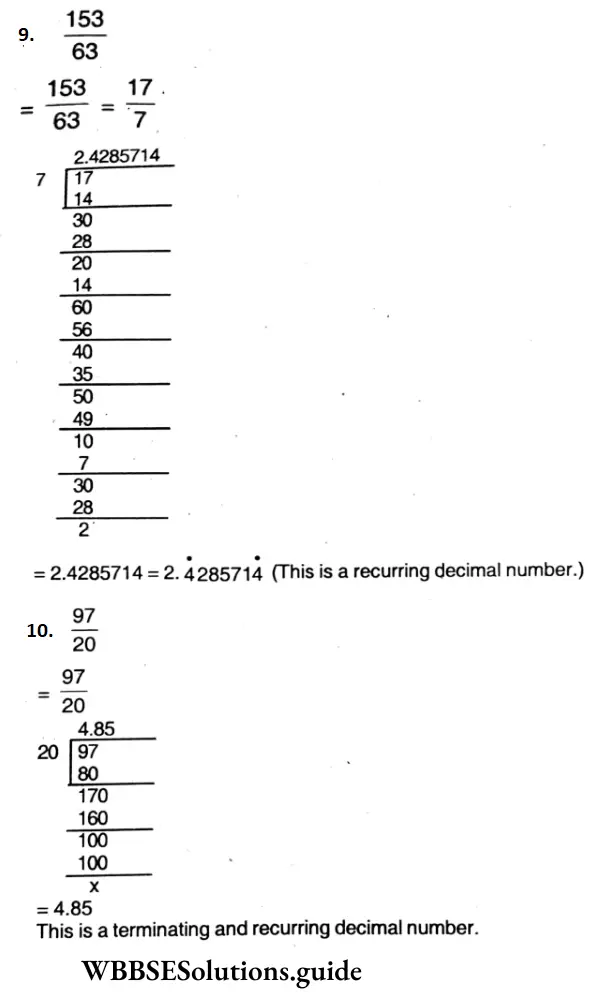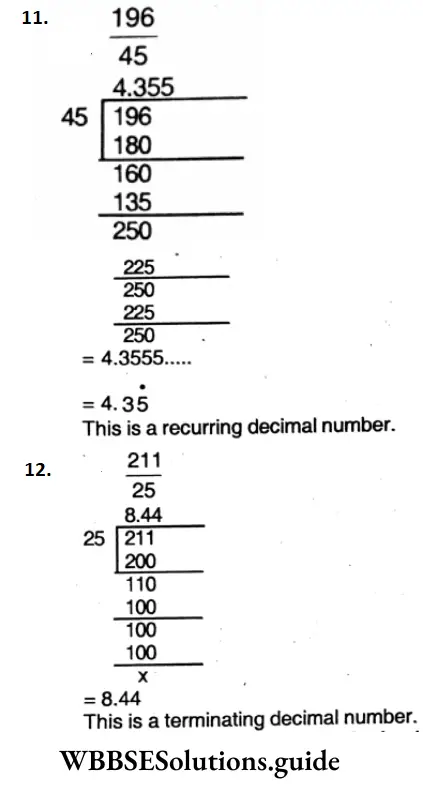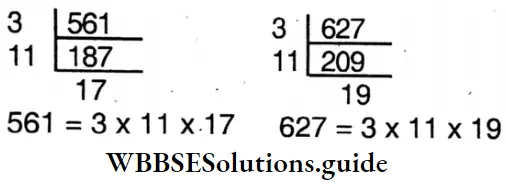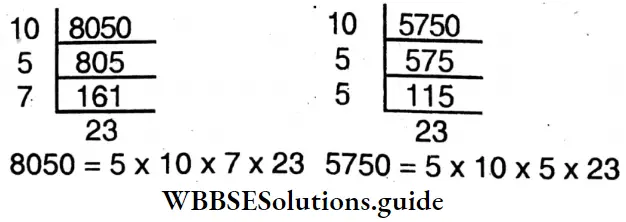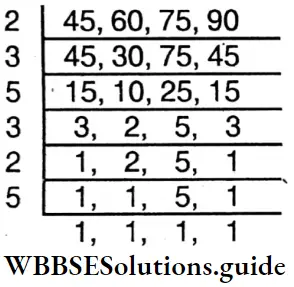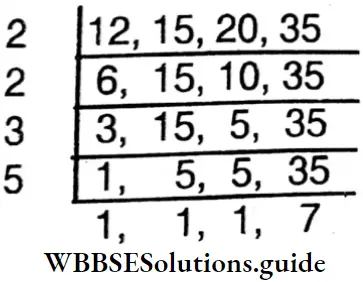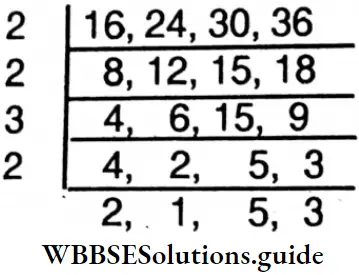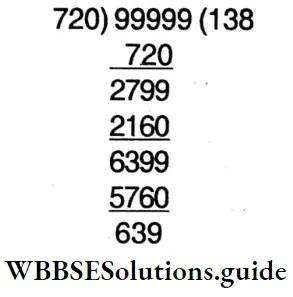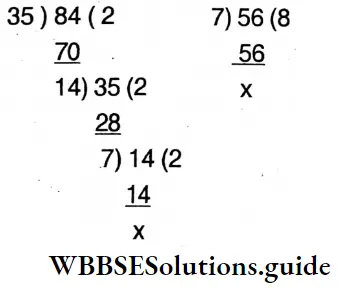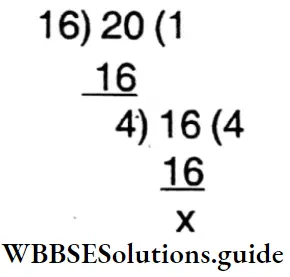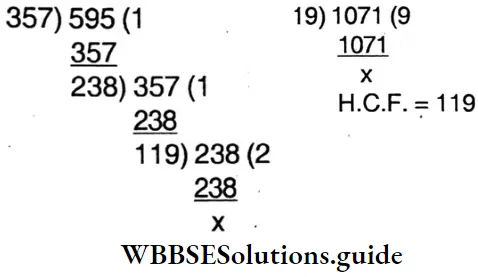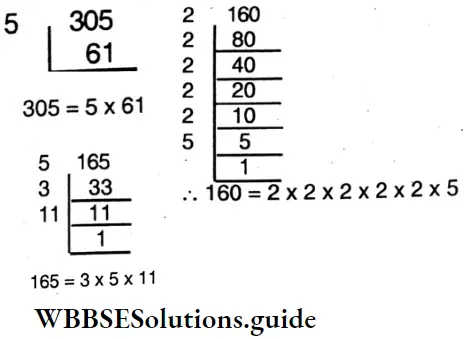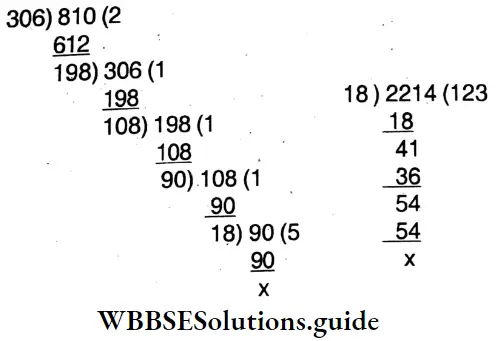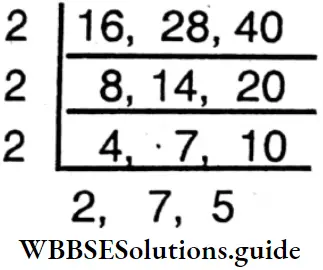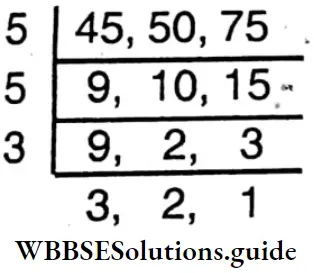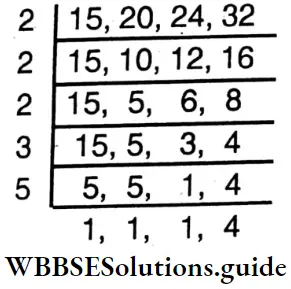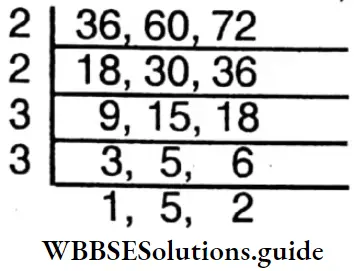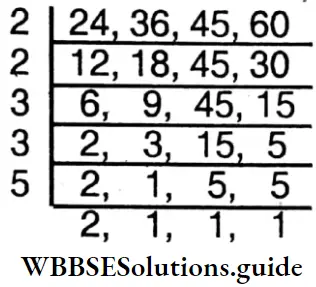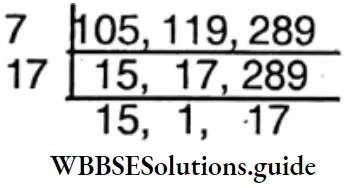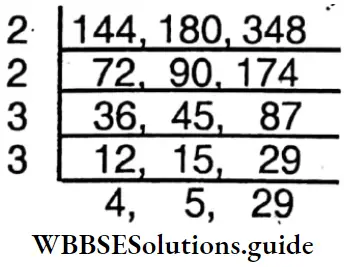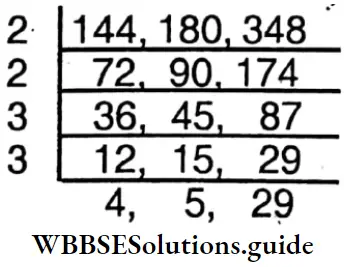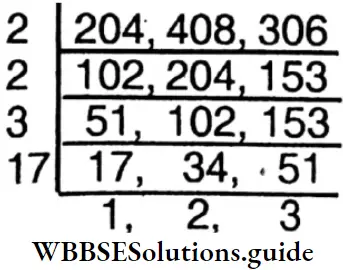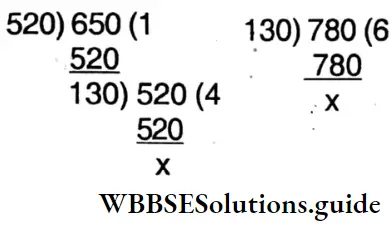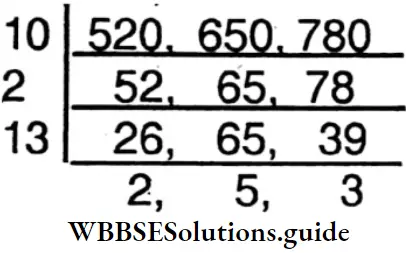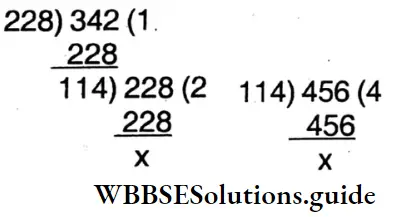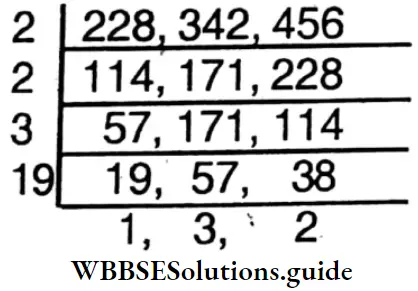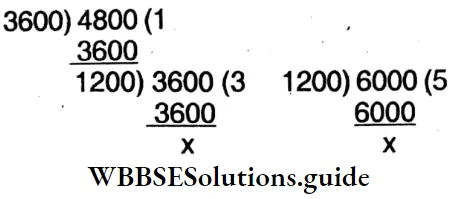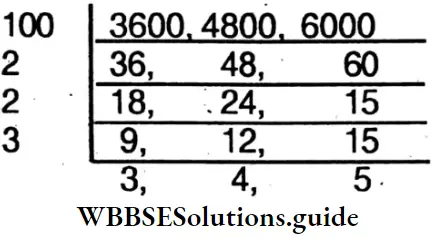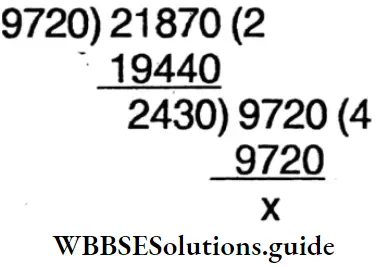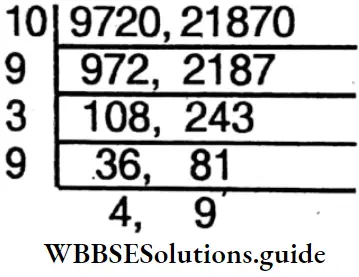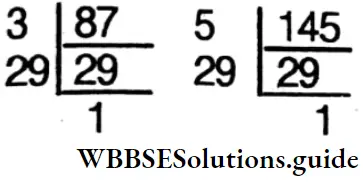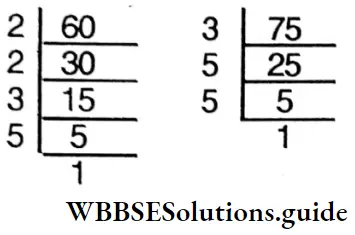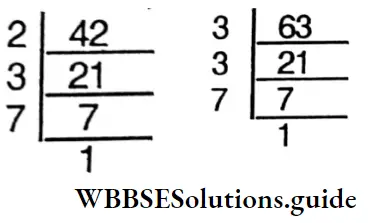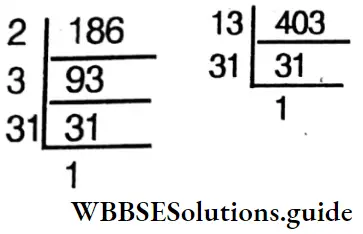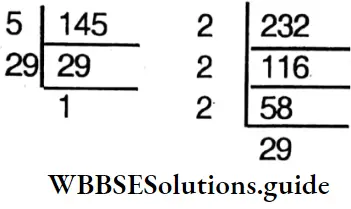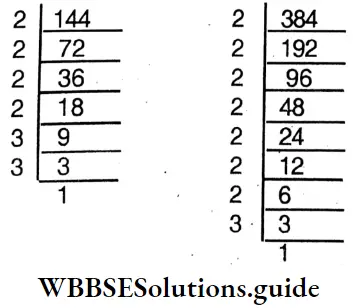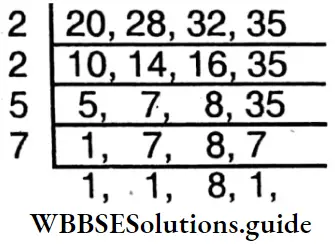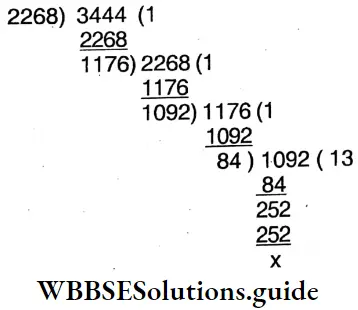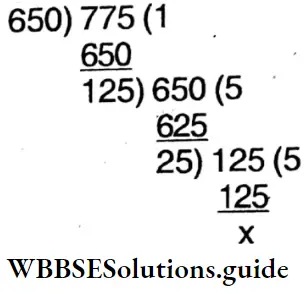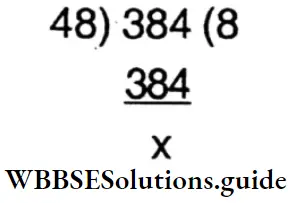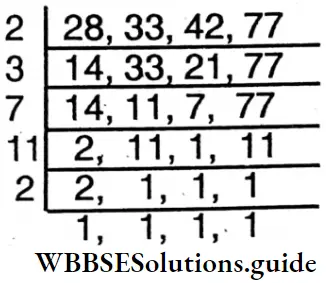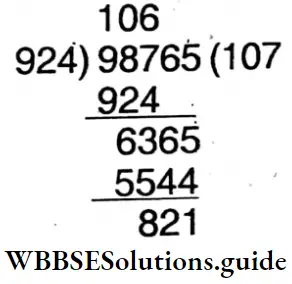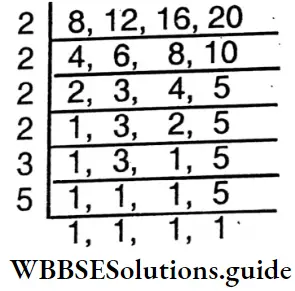Class 6 Math Solutions WBBSE Chapter 6 Multiplication And Division Of A Fraction By Whole Number And By Fraction Exercise 6
Question 1. Hands-on trial Four circular pieces of paper of equal size are taken. Half a portion of the circles are colored. Let us see what we can do with colored half positions.
Solution:

4 x \(\frac{1}{2}\) → \(\frac{1}{2}\) + \(\frac{1}{2}\) + \(\frac{1}{2}\) + \(\frac{1}{2}\) = 2
Hence, 4 x \(\frac{1}{2}\) = \(\frac{1}{2}\) + \(\frac{1}{2}\) + \(\frac{1}{2}\) + \(\frac{1}{2}\) = \(\frac{1+1+1+1}{2}\) = \(\frac{4}{2}\) = 2
Or, 4x\(\frac{1}{2}\) = \(\frac{1\times1}{2}\) = 2
Read and Learn More WBBSE Solutions For Class 6 Maths
Again, let us take four circular pieces of paper of equal size. \(\frac{3}{4}\) part of it are coloured. Let us find what is the sum total of coloured portions.

4 x \(\frac{3}{4}\) = \(\frac{3}{4}\) + \(\frac{3}{4}\) + \(\frac{3}{4}\) + \(\frac{3}{4}\) = 3
4 x \(\frac{3}{4}\) = \(\frac{3+3+3+3}{4}=\) = 3 or 4 x \(\frac{3}{4}\) = \(\frac{4 \times 3}{4}\) = 3
Class 6 Math Solutions WBBSE
Question 2. If 8 equal pieces \(\frac{1}{2}\) of 12 equal pieces of \(\frac{3}{4}\) meter and 16 equal pieces of \(\frac{3}{8}\) meter of ribbon are needed, let us find what length of ribbon will be required in all.
Solution:
8 pieces of \(\frac{1}{2}\) meter = 8 x \(\frac{1}{2}\)m = \(\frac{8 \times 1}{2}\) = \(\frac{8}{2}\) = 4 m.
12 pieces of \(\frac{3}{4}\) metre = 12 x \(\frac{3}{4}\) m = \(\frac{16 \times 3}{4}\) = 6 m.
Total length of ribbon required = 4m + 9m + 6m = 19m.
Question 3. (1)

Solution: That is 3 x \(\frac{1}{4}\) = \(\frac{3}{4}\)
(2)

Solution: 3 x \(\frac{2}{5}\) = \(\frac{6}{5}\) = 1 + \(\frac{1}{5}\)
(3) Let us color and deduce
Solution:
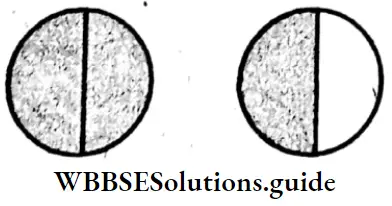
1 + \(\frac{1}{2}\) = 1\(\frac{1}{2}\) = \(\frac{3}{2}\)
Class 6 Math Solutions WBBSE
(4) Similarly, colour twice and let us bring together the colored position to conclude
Solution:

⇒ \(\frac{3}{2}\) + \(\frac{3}{2}\) = 3
Hence, 2 x \(\frac{3}{2}\) = 3.

(5 + \(\frac{2}{5}\)) = 5\(\frac{2}{5}\) = \(\frac{27}{5}\)
(5) Let us draw three similar pictures and let us find the total color portions.
Solution:
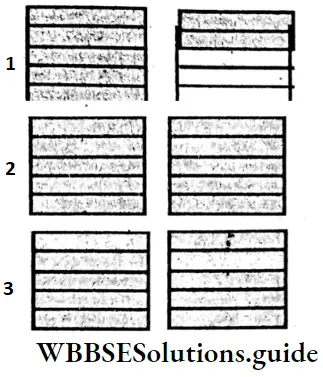
1. 1 + \(\frac{2}{5}\) = 1\(\frac{2}{5}\) = \(\frac{7}{5}\)
2. 1 + \(\frac{3}{5}\) = \(\frac{8}{5}\)
3. 1 + \(\frac{4}{5}\) = \(\frac{9}{5}\)
Class 6 WBBSE Math Solutions
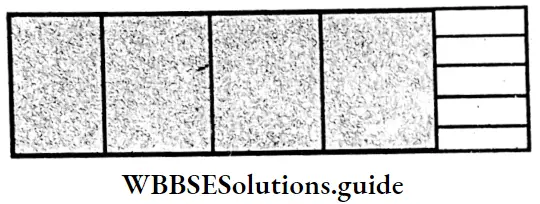
3 x \(\frac{7}{5}\) = \(\frac{7 \times 3}{5}\) = \(\frac{21}{5}\) = 4\(\frac{1}{5}\)
7 x \(\frac{3}{5}\) = 4 + \(\frac{1}{5}\)
Let us calculate and color accordingly
(6) 3 x \(\frac{3}{4}\) = \(\frac{3 \times 3}{4}\) = \(\frac{9}{4}\) = 2\(\frac{1}{4}\)
Solution:

(7) 2 x \(\frac{7}{6}\) = \(\frac{2 \times 7}{6}\) = \(\frac{14}{6}\) = \(\frac{7}{3}\) = 2\(\frac{1}{3}\)
Solution:
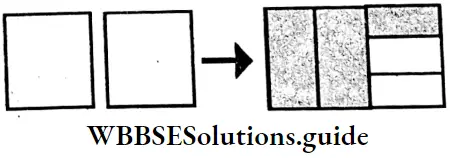
Class 6 WBBSE Math Solutions Chapter 6 Multiplication And Division Of A Fraction By Whole Number And By Fraction Exercise 6.1
Question 1. Sraboni had Rs. 100. She spent \(\frac{1}{2}\) of her money at a bookshop and \(\frac{1}{4}\) of her money at a grocery shop. Let us find how much money she paid at the book shop and at the grocery and how much money is left with her.
Solution:
At book shop, Sraboni paid \(\frac{1}{2}\) part of Rs. 100
= Rs. 100 x \(\frac{1}{2}\) = Rs. \(\frac{100 \times 1}{2}\) = Rs. \(\frac{100}{2}\) = Rs. 50
At the grocery, she paid \(\frac{1}{4}\) part of Rs. 100
= Rs. 100 x \(\frac{1}{4}\) = Rs. \(\frac{100 \times 1}{4}\) = Rs. \(\frac{100}{4}\) = Rs. 25.
Hence, Sraboni is left with Rs. 100 – (Rs. 50 + Rs. 25)
= Rs. 100 – Rs. 75 = Rs. 25
Question 2. In our art class, we were asked to draw a scenery. Samir took \(\frac{2}{5}\) part of 1 hr, Mita took \(\frac{5}{12}\) part of 1 hr, Ajij did it in \(\frac{1}{2}\) part of 1 hr and Sabbar finished it in \(\frac{7}{12}\) part of 1 hr. Let us calculate how much time each of them took to draw the scenery and also who took maximum time to finish the work and who took minimum time.
Solution:
∴ 1 hr = 60 min.
Samir finished his drawing in \(\frac{2}{5}\) part of 1 hr.
i.e., \(\frac{2}{5}\) of 60 min = 60 min x \(\frac{2}{5}\) = \(\frac{60 \times 2}{5}\) min = 24 min.
Mita finished her drawing in \(\frac{5}{12}\) of 1 hr, i.e., \(\frac{5}{12}\) of 60 min
= 60 min x \(\frac{5}{12}\) = \(\frac{60 \times 5}{12}\) min = 25 min.
Similarly, Ajij finished his drawing in \(\frac{1}{2}\) part of 1 hr = 30 min
Sabbar look \(\frac{7}{12}\) part of 1 hr = 60 min x \(\frac{7}{12}\) = 35 min.
Hence, to draw the same scenery Samir took minimum time and Sabbar took maximum time.
Class 6 WBBSE Math Solutions
Question 3. For a school picnic, Rehena paid \(\frac{5}{6}\) part of Rs. 30 and Javed paid \(\frac{5}{9}\) part of Rs. 45. Let us find who paid more.
Solution:
Rehana paid \(\frac{5}{6}\) part of Rs. 30 = Rs. 25 and Javed paid \(\frac{5}{9}\) part of 45 =
Rs. 25.
Hence, Rahana and Javed both paid Rs. 25.
Question 4. Let us express \(\frac{5}{8}\) part of Rs. 2 in rupees and paise.
Solution:
Rs. 2 = 200 paise
Hence, \(\frac{5}{8}\) part of Rs. 2 = \(\frac{5}{8}\) part of 200 paise
= 200 x \(\frac{5}{8}\) paisa = 125 paise = Re 1 and 25 paise.
Question 5. Let us multiply
1. 120 x \(\frac{3}{5}\)
Solution: 24 x 3 = 72
2. 2 x 215 x \(\frac{3}{5}\)
Solution: 2 x 43 x 3 = 258
3. 500 x \(\frac{17}{25}\)
Solution: 20 x 17 = 340
4. 169 x \(\frac{4}{13}\)
Solution: 13 x 4 = 52
Question 6. Lets do it
WBBSE Math Solutions Class 6
1. \(\frac{3}{4}\) of 1 year = ____ month
Solution: \(\frac{3}{4}\) of 1 year = \(\frac{3}{4}\) x 12 months = 3 x 3 = 9 months
2. \(\frac{3}{4}\) of Rs. 5 = ____ paise
Solution: \(\frac{3}{4}\) of Rs. 5 = \(\frac{3}{4}\) x 500 paise = 3 x 125 = 375 paise
3. \(\frac{3}{5}\) of 60 apples = _______ apples
Solution: \(\frac{3}{5}\) of 60 apples = 3 x 12 apples = 36 apples
4. \(\frac{3}{20}\) of 40 litre = ___ litre
Solution: \(\frac{3}{20}\) of 40 litre = 3 x 2 = 6 litre
Let Us Measure Land
Question 7. Rahim uncle planted flowering plants in half portion of his rectangular field. The length and breadth of the field are 50 metre and 40 metre respectively.
Solution:
Area of Rahim uncle’s field = (50 x 40) sq.m = 2000 sq.m.
\(\frac{1}{2}\) portion of 2000 sq.m, of field = \(\frac{1}{2}\) x 2000 sq.m = 2000 sq.m.
Hence, he planted flowering plants in 1000 sq.m, of field.
But in half a portion of his flower garden, Rahim uncle planted marigold. Therefore, marigold is planted in \(\frac{1}{2}\) part of 1000 sq.m
= 1000 x \(\frac{1}{2}\) sq.m = 500 sq.m.
Total land = 2000 sq.m.
Hence, 500 sq.m = \(\frac{500}{2000}\) part of 2000 sq.m. = \(\frac{1}{4}\) part.
i. e., he has planted marigolds in \(\frac{1}{4}\) part of his land. He planted marigolds or half of half portion of his land
= \(\frac{1}{2}\) of \(\frac{1}{2}\) portion of land = \(\frac{1}{2}\) x \(\frac{1}{2}\) = \(\frac{1}{4}\) part.
WBBSE Math Solutions Class 6 Chapter 6 Multiplication And Division Of A Fraction By Whole Number And By Fraction Exercise 6.2
Question 1. Rohit can walk 1\(\frac{1}{2}\) km in 1 hr. Let us find how far he can walk in 6\(\frac{1}{2}\) hrs. [1\(\frac{1}{2}\) km= \(\frac{3}{2}\) km; 6\(\frac{1}{2}\) hrs = \(\frac{3}{2}\) hrs]
Solution:
Rohit can walk in 1 hr 1\(\frac{1}{2}\) km = \(\frac{3}{2}\) km.
∴ Rohit can walk in 6\(\frac{1}{2}\) hr = \(\frac{13}{2}\) hr = \(\frac{3}{2}\) x \(\frac{13}{2}\) = \(\frac{39}{4}\) km = 9\(\frac{3}{4}\) km
Question 2. Rafikul’s uncle built a house on \(\frac{3}{5}\) of \(\frac{4}{7}\) part of his land and the rest of the land is left for cultivation. Let us find out on what part of land he built his house.
Solution:
Rafikul’s uncle built a house on \(\frac{3}{5}\) of \(\frac{4}{7}\) part of his land.
Part of the land he built his house on = \(\frac{3}{5}\) x \(\frac{4}{7}\) = \(\frac{12}{35}\) Part
Question 3. Let us multiply the following:
1. \(\frac{2}{3}\) x \(\frac{5}{6}\)
Solution: 5/9
2. \(\frac{7}{8}\) x \(\frac{3}{10}\)
Solution: 21/80
WBBSE Class 6 Maths Solutions
3. 19\(\frac{3}{4}\) x \(\frac{1}{7}\)
Solution:
= \(\frac{79}{4} \times \frac{1}{7}=\frac{79}{28}\)
= \(2 \frac{23}{28}\)
4. \(\frac{16}{5}\) x \(\frac{4}{7}\)
Solution: \(\frac{432}{35}\) = 12\(\frac{12}{35}\)
Question 4. The product of two proper fractions is always a ____ (proper Aim- proper) fraction.
Solution: The product of two proper fractions is always a proper fraction.
Example: \(\frac{3}{7} \times \frac{5}{5}=\frac{6}{35}\)
Question 5. The product of two improper fractions is always a/an ______ (proper/improper) fraction.
Solution: The product of two improper fractions is always an improper fraction.
Example: \(\frac{8}{3} \times \frac{11}{5}=\frac{88}{15}\)
WBBSE Class 6 Maths Solutions Chapter 6 Multiplication And Division Of A Fraction By Whole Number And By Fraction Exercise 6.3
Question 1. Few friends have come at Ayesha’s House. Ayesha brought 6 apples. Each friend ate 1— apple and no apples were left. Let’s find out how many friends of Ayesha ate apples.
Solution:
Number of apples = 6.
Each friend ate 1\(\frac{1}{2}\) apples = \(\frac{3}{2}\) apples.
∴ Number of friends = 6 ÷ \(\frac{3}{2}\)= 6 x \(\frac{2}{3}\) = 4
Question 2. There are 9 boiled eggs if each wants to have 1\(\frac{1}{2}\) eggs, let’s find how many can eat eggs.
Solution:
Total number of eggs = 9
Each want to have = 1\(\frac{1}{2}\) = \(\frac{3}{2}\) eggs
Number of persons =9÷ \(\frac{3}{2}\) = 9x\(\frac{2}{3}\)=6
WBBSE Class 6 Maths Solutions
Question 3. There are 5 packets of biscuits. If each person eats \(\frac{1}{4}\) part of a packet of biscuit, let’s find how many persons can eat the biscuits.
Solution:
Number of packs of biscuits = 5
Each person eats \(\frac{1}{4}\) part of a packet.
∴ Number of persons = 5 x \(\frac{4}{1}\) = 20
Question 4. Let’s find the values of the following
1. 4 ÷ \(\frac{1}{3}\)
Solution: 4×3 = 12
2. 3 ÷ \(\frac{1}{6}\)
Solution: 3×6 = 18
3. 8 ÷ \(\frac{1}{5}\)
Solution: 8X5 = 40
4. 5 ÷ \(\frac{1}{4}\)
Solution: 5×4 = 20
5. 6 ÷ \(\frac{1}{2}\)
Solution: 6×2 = 12
6. 15 ÷ \(\frac{5}{7}\)
Solution: 15x\(\frac{7}{5}\) = 21
7. 20 ÷ \(\frac{4}{5}\)
Solution: 20 x \(\frac{5}{4}\) = 25
8. 9 ÷ 1\(\frac{2}{25}\)
Solution: 9 \(\frac{27}{25}\)
= 9 ÷ \(\frac{27}{25}\)
= 9 x \(\frac{25}{27}\) = \(\frac{25}{3}\) = 8\(\frac{1}{3}\)
9. 7 ÷ 2\(\frac{3}{16}\)
Solution: 7 ÷ \(\frac{35}{16}\)
= 7 x \(\frac{16}{35}\) = 7x\(\frac{16}{5}\) = 3\(\frac{1}{5}\)
10. 4 ÷ 2\(\frac{10}{13}\)
Solution: 4 ÷ \(\frac{36}{13}\)
= \(4 \times \frac{13}{36}=\frac{13}{9}=1 \frac{4}{9}\)
WBBSE Class 6 Maths Solutions
11. 11 ÷ \(\frac{55}{18}\)
Solution: 11 x \(\frac{18}{55}\)
= \(\frac{18}{5}\) = 3\(\frac{3}{5}\)
12. 18 ÷ \(\frac{3}{5}\)
Solution: 18 x \(\frac{5}{3}\) = 6 x 5 = 30
Chapter 6 Multiplication And Division Of A Fraction By Whole Number And By Fraction Exercise 6.4
Question 1. Let’s find the values of the following:
1. \(\frac{7}{8} \div \frac{21}{5}\)
Solution:
= \(\frac{7}{8} \times \frac{5}{21}=\frac{5}{24}\)
2. \(\frac{3}{28} \div \frac{9}{7}\)
Solution:
= \(\frac{3}{28} \times \frac{7}{9}=\frac{1}{12}\)
3. \(5 \frac{2}{3} \div \frac{1}{6}\)
Solution:
= \(\frac{17}{3} \times \frac{6}{1}=34\)
4. ______ ÷ __________
Solution:
= \(\frac{4}{7} \div \frac{12}{21}=\frac{4}{7} \times \frac{21}{12}=1\)
WBBSE Class 6 Maths Solutions
Question 2. 1. Let’s do mentally
(1) How much is \(\frac{1}{2}\) of Rs. 10?
Solution: \(\frac{1}{2}\) of Rs. 10 = Rs. 5.
(2) How much is \(\frac{1}{5}\) part of Rs. 25?
Solution: \(\frac{1}{5}\) of Rs. 25 = Rs. \(\frac{1}{5}\) x 25 = Rs. 5.
(3) \(\frac{1}{3}\) of how much is Rs. 4?
Solution: Let \(\frac{1}{3}\) of Rs. x = 4
∴ x = Rs. 4 x 3 = Rs. 12.
(4) \(\frac{1}{4}\)part of what time is 65 min?
Solution: Let \(\frac{1}{3}\) of x min = 65
∴ x = 65 x 6 = 390 min.
(5) I have taken \(\frac{1}{3}\) part of mangoes from Mala’s basket of mangoes. If I have taken 7 mangoes, how many mangoes Mala had in her basket, let’s find.
Solution: \(\frac{1}{3}\) part of mangoes from Mala’s basket = 7.
∴ Total number of mangoes of Mala’s basket = 7÷\(\frac{1}{3}\) = 7 x 3 = 21
(6)
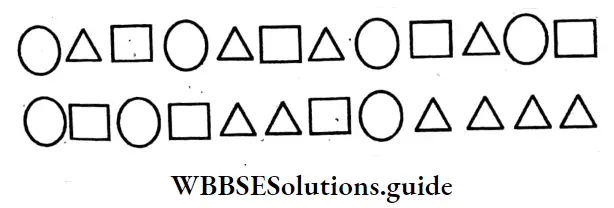
Solution:

Total circles = 7; \(\frac{2}{7}\) part of 7 circles = 2.
Total triangles = 10; \(\frac{3}{5}\) part of 10 triangles = 6.
Total quadrilaterals = 7; \(\frac{1}{7}\) part of 7 quadrilaterals = 1.
(7) Today father has brought 10 I of drinking water from a nearby tubewell. Mother used \(\frac{1}{5}\) part of water for cooking and \(\frac{1}{4}\) part of remaining water was used for drinking purpose. Let us find how many liters of water is left.
Solution:
Class 6 Maths Solutions WBBSE
Quantity of drinking water = 10 litres
Mother used water for cooking = \(\frac{1}{5}\) x 10 litres = 2 litres
Remaining water = (10-2) litre = 8 litres
Used for drinking water = \(\frac{1}{4}\) x 8 liters = litres
Remaining water = (8- 2) litres = 6 litres
Question 3. Let’s find the value of:
1. \(3 \times \frac{6}{11}\)
Solution:
= \(\frac{18}{11}=1 \frac{7}{11}\)
2. \(11 \times \frac{2}{3}\)
Solution:
= \(\frac{22}{3}=7\frac{1}{3}\)
3. \(\frac{7}{3} \times 2 \frac{3}{2}\)
Solution:
= \(\frac{7}{3} \times \frac{7}{2}=\frac{49}{6}=8 \frac{1}{6}\)
4. \(\frac{3}{8} \times \frac{6}{4}\)
Solution:
= \(\frac{3 \times 6}{8 \times 4}=\frac{9}{16}\)
5. \(\frac{6}{49} \times \frac{7}{3}\)
Solution:
= \(\frac{6 \times 7}{49 \times 3}=\frac{2}{7}\)
6. \(\frac{15}{28} \times 2 \frac{1}{3}\)
Solution:
= \(\frac{15}{28} \times \frac{7}{3}=\frac{5}{4}\)
7. \(4 \frac{8}{13} \times 7 \frac{4}{5}\)
Solution:
= \(\frac{60}{13} \times \frac{39}{5}=36\)
Question 4. A bucket holds \(\frac{1}{2}\) liter of water. Let us calculate how much water 7 such buckets can hold.
Solution:
A bucket holds = \(\frac{1}{2}\) litre water
∴ 7 such buckets contain = 7 x \(\frac{1}{2}\) litres = \(\frac{7}{2}\) = 3.5 litres water.
Class 6 Maths Solutions WBBSE
Question 5. After retirement, Akhilbabu donated \(\frac{1}{4}\) part of his property to the local library, \(\frac{1}{6}\) part of the remaining property was given to his wife and rest was divided equally among his two sons. Let us calculate to find what part of his property was given to his wife and each of two sons.
Solution:
Akhilbabu donated = \(\frac{1}{4}\) part to local library.
Remaining part = 1 – \(\frac{1}{4}\) = \(\frac{4-1}{4}\) = \(\frac{3}{4}\) part.
Wife received = \(\frac{1}{6}\) x \(\frac{3}{4}\) = \(\frac{1}{8}\) part.
Remaining part= \(\frac{3}{4}\) – \(\frac{1}{8}\) = \(\frac{3 \times 2 -1}{8}\) = \(\frac{5}{8}\)
∴ Two sons will get = \(\frac{5}{8}\) part.
Each son received = \(\frac{1}{2}\) X \(\frac{5}{8}\) = \(\frac{5}{16}\) part.
Question 6. From \(\frac{1}{2}\) part of Rs. 150, how much is to be taken away so that only Rs. 30 is left?
Solution:
⇒ \(\frac{1}{2}\) part of Rs. 150 = 150 x \(\frac{1}{2}\) = Rs. 75
Remaining money = Rs. 30.
We will take = Rs. 75 — Rs. 30 = Rs. 45
Question 7. Let us find the value when 3 times of \(\frac{6}{7}\) is added to 2\(\frac{6}{7}\)
Solution:
= 3 times of \(\frac{6}{7}\) + \(\frac{20}{7}\)
= 3 X \(\frac{6}{7}\) + \(\frac{20}{7}\)= \(\frac{38}{7}\)
=5\(\frac{1}{7}\)
Question 8. In the first year the cultural program of the town had 1400 spectators. Next year the number increased by \(\frac{7}{10}\) parts let’s find the total number of next year.
Solution:
Number of spectators = 1400.
Next year spectators increased by \(\frac{7}{10}\)
i.e., \(\frac{7}{10}\) x 1400 = 980
Total number of spectators in next year = 1400 + 980 = 2380
Class 6 Maths Solutions WBBSE
Question 9. Let’s find the reciprocals of the following fractions and mark the reciprocals by ‘O’ sign which are proper fractions:
Solution:
1. Reciprocal of \(\frac{7}{5}=\frac{5}{7}\)
2. Reciprocal of \(\frac{1}{3}\) = 3
3. Reciprocal of \(\frac{5}{8}=\frac{8}{5}\)
4. Reciprocal of \(\frac{9}{7}=\frac{7}{9}\)
5. Reciprocal of \(\frac{12}{5}=\frac{5}{12}\)
6. Reciprocal of \(\frac{5}{8}=\frac{8}{5}\)
7. Reciprocal of \(\frac{1}{8}=\frac{8}{1}\)
Question 10. Which number has reciprocal as itself?
Solution: The number which has reciprocal as itself = 1.
Question 11. Sita gives me \(\frac{2}{3}\) part of the total number of stamps she has. If she gives me 18 stamps, let us find how many stamps Sita has.
Solution:
2/3 part of total number of stamps = 18.
∴ Total number of stamps of Sita = 18 \(\frac{2}{3}\) = 18 x \(\frac{3}{2}\) = 27.
Question 12. Rajia gave \(\frac{2}{5}\) part of her money to Debnath and \(\frac{3}{10}\) part of money to Sunita. If she has Rs. 180 left, let us find how much money Rajia had at the begining.
Solution:
Rajia gave \(\frac{2}{5}\) part and \(\frac{3}{10}\) part of her money to Debnath and Sunita respectively.
∴ She gave \(\frac{2}{5}+\frac{3}{10}=\frac{4+3}{10}=\frac{7}{10}\) part of money.
Remaining part of her money = \(1-\frac{7}{10}=\frac{10-7}{10}=\frac{3}{10}\)
According to problem, \(\frac{3}{10}\) part of money = Rs. 180
∴ Total amount of money she had = Rs. 180 x \(\frac{10}{3}\) = Rs. 600.
Question 13. Let’s find the values
1. \(15 \div \frac{5}{3}\)
Solution:
= \(15 \times \frac{3}{5}=9\)
2. \(14 \div \frac{7}{2}\)
Solution:
= \(14 \times \frac{2}{7}=4\)
3. \(\frac{6}{13} \div 3\)
Solution:
= \(\frac{6}{13} \times \frac{1}{3}=\frac{2}{13}\)
4. \(\frac{12}{19} \div 6\)
Solution:
= \(\frac{12}{19} \times \frac{1}{6}=\frac{2}{19}\)
5. \(5 \frac{1}{5} \div \frac{13}{2}\)
Solution:
= \(5 \frac{1}{5} \div \frac{13}{2}=\frac{26}{5} \times \frac{2}{13}=\frac{4}{5}\).
Class 6 Maths Solutions WBBSE
6. \(2 \frac{2}{5} \div 1 \frac{1}{5}\)
Solution:
= \(2 \frac{2}{5} \div 1 \frac{1}{5}=\frac{12}{5} \div \frac{6}{5}=\frac{12}{5} \times \frac{5}{6}=2\)
7. \(4 \frac{3}{7} \div 3 \frac{2}{7}\)
Solution:
= \(\frac{31}{7} \div \frac{23}{7}=\frac{31}{7} \times \frac{7}{23}=\frac{31}{23}=1 \frac{8}{23}\).
Question 14. Let’s mark ‘√’ for the correct answer
1. How many \(\frac{1}{16}\) are there in \(\frac{3}{4}\)?
- 64
- 12
- 4
- 3
Solution:
Required no. = \(\frac{3}{4}\) ÷ \(\frac{1}{16}\)
= \(\frac{3}{4}\) x \(\frac{16}{1}\)
∴ 2. 12.
2. \(\frac{3}{4}\) part of a ribbon is 56 m. Let’s calculate the original length of the ribbon.
- 43 m
- 64 m
- 63 m
- 72 m
Solution: Original length of the ribbon
= 56 m x \(\frac{8}{7}\) = 64 m
∴ 2. 64 m
3. Reciprocal of 5\(\frac{6}{7}\) will be
- 5\(\frac{3}{4}\)
- \(\frac{41}{7}\)
- \(\frac{7}{41}\)
- \(\frac{7}{56}\)
Solution: Reciprocal of 5\(\frac{6}{7}\), i.e., \(\frac{41}{7}\)= \(\frac{7}{41}\)
∴ 3. \(\frac{7}{41}\)
Question 15. From 16\(\frac{2}{3}\)m long ribbon, \(\frac{3}{8}\) part is cut off. If it is further divided into 5 equal pieces, let’s find the length of each pieces.
Solution:
Length of the ribbon = \(16 \frac{2}{3}=\frac{50}{3}\) m
⇒ \(\frac{3}{8} \text { part }=\frac{50}{3} \times \frac{3}{8}=\frac{50}{8} \mathrm{~m}=\frac{25}{4} \mathrm{~m}\)
∴ Length of each piece = \(\frac{25}{4} \div 5=\frac{25}{4} \times \frac{1}{5}=\frac{5}{4} m .=1 \frac{1}{4} m\)
Question 16. Father bought 12\(\frac{7}{10}\) m of cloth for window curtains. But there was already 5\(\frac{3}{5}\)m of cloth for curtains at home. 4\(\frac{5}{6}\) m of cloth is required to make curtains for each of 3 windows. What length of cloth will remain?
Solution:
Length of cloth
= \(12 \frac{7}{10} \mathrm{~m}+5 \frac{3}{5} \mathrm{~m}\)
= \(\frac{127}{10}+\frac{28}{5}\)
= \(\frac{127+56}{10} \mathrm{~m}\)
= \(\frac{183}{10} \mathrm{~m} .\)
Cloth required to make one curtain = \(4 \frac{5}{6} m=\frac{29}{6} m\)
∴ To make 3 curtains cloth required = \(\frac{29}{6} \times 3 \mathrm{~m}=\frac{29}{2} \mathrm{~m}\)
Remaining cloth = \(\frac{183}{10} m-\frac{29}{2} m\)
= \(\frac{183-145}{10} m=\frac{38}{10}m\)
= \(\frac{19}{5}m=3\frac{4}{5}m\)
Question 17. My grandmother prepared some pickle. She removed \(\frac{4}{7}\) part of the pickle in a glass jar for future use. Rest she divided among 6 of us. Let’s find how much each of us will get.
Solution:
Grandmother removed \(\frac{4}{7}\) part of the pickle.
Remaining part = \(1-\frac{4}{7}=\frac{7-4}{7}=\frac{3}{7} \text { part. }\)
∴ \(\frac{3}{7}\) part was divided among 6 of us.
∴ Each of us will get = \(\frac{3}{7} \div 6=\frac{3}{7} \times \frac{1}{6}=\frac{1}{14} \text { part. }\)
Question 18. Mehboob and his group have decided that in 33 days they would repair 24\(\frac{11}{15}\) km of road. They repaired \(\frac{11}{15}\) km of road each day for 25 days. If they are to finish the work in due time, at what rate they would work for the remaining days?
Solution:
They repaired in each day = \(\frac{11}{15}\) km.
∴ They repaired in 25 days = \(\frac{11}{15}\) x 25 = \(\frac{55}{3}\) km
∴ Remaining work = 24\(\frac{11}{15}\) – \(\frac{55}{3}\) = \(\frac{371}{15}\) – \(\frac{55}{3}\) = \(\frac{371-275}{15}=\frac{96}{15} \mathrm{~km}\)km.
Remaining days = 33 – 25 = 8.
∴ In 8 days they have to repair \(\frac{35}{5}\) km.
∴ In 1 day they will repair \(\frac{32}{5} \times \frac{1}{8}=\frac{4}{5} \mathrm{~km}\)
Multiplication For Class 6
Question 19. 5 is added to —\(\frac{3}{7}\) and the sum is multiplied by 4\(\frac{2}{3}\) Now, the product is divided by 4\(\frac{4}{9}\) and the quotient is subtracted from 8\(\frac{2}{5}\). Let’s find the number after subtraction.
Solution:
⇒ \(5+\frac{3}{7}=\frac{35+3}{7}=\frac{38}{7}\)
The sum is multiplied by \(4 \frac{2}{3}\).
∴ \(\frac{38}{7} \times 4 \frac{2}{3}=\frac{38}{7} \times \frac{14}{3}=\frac{76}{3}\)
Then the product is divided by 4\(\frac{4}{9}\)
i.e., \(\frac{76}{3} \div 4 \frac{4}{9}=\frac{76}{3} \div \frac{40}{9}=\frac{76}{3} \times \frac{9}{40}=\frac{57}{10}\)
The quotient is subracted from 8\(\frac{2}{5}\).
i.e., \(8 \frac{2}{5}-\frac{57}{10}=\frac{42}{5}-\frac{57}{10}=\frac{84-57}{10}\)
= \(\frac{27}{10}=2 \frac{7}{10}\)
∴ Required No. = \(2 \frac{7}{10}\)
Multiplication For Class 6
Question 20. Let us simplify
1. \(\frac{1}{5}+\frac{2}{3}-\frac{1}{2}\)
Solution:
= \(\frac{6+20-15}{30}=\frac{26-15}{30}=\frac{11}{30}\)
2. \(\frac{1}{5}+\frac{1}{2}\)–\(\frac{2}{15}-\frac{1}{6}\)
Solution:
= \(\frac{6+15-4-5}{30}=\frac{26-9}{30}=\frac{12}{30}=\frac{2}{5}\)
3. \(\frac{7}{12}+5 \frac{2}{9}+\frac{11}{18}-2 \frac{5}{12}\)
Solution:
= \(\frac{7}{12}+\frac{47}{9}+\frac{11}{18}-\frac{29}{12} \)
= \(\frac{21+188+22-87}{36}\)
= \(\frac{231-87}{36}\)
= \(\frac{144}{36}\) = 4
4. \(3 \frac{1}{2}+\frac{7}{6} \times \frac{3}{8}-\frac{5}{24}\)
Solution:
= \(\frac{7}{2}+\frac{7}{16}-\frac{5}{24}\)
= \(\frac{168+21-10}{48}=\frac{189-10}{48}=\frac{179}{48}=3 \frac{35}{48}\)
5. \(\frac{3}{8} \div \frac{2}{3}\) of \(\frac{1}{9}\) of \(\frac{1}{16}\)
Solution:
= \(\frac{3}{8} \div \frac{2}{3} \times \frac{1}{9} \times \frac{1}{16}\)
= \(\frac{3}{8} \div \frac{1}{3 \times 9 \times 8}=\frac{3}{8} \times \frac{3 \times 9 \times 8}{1}=81\)
6. \(6 \frac{2}{5}+3 \frac{1}{3}+\frac{1}{2}-\frac{7}{10}\)
Solution:
= \(\frac{192+100+15-21}{30}=\frac{307-21}{30}=\frac{286}{30}=9 \frac{8}{15}\)
Division For Class 6
7. \(\left\{\frac{11}{16} \div\left(\frac{5}{6}+\frac{2}{3}\right)\right\}-\frac{1}{3}\)
Solution:
= \(\left(\frac{11}{16} \div \frac{9}{6}\right)-\frac{1}{3}=\left(\frac{11}{16} \times \frac{6}{9}\right)-\frac{1}{3}\)
= \(\frac{11}{24}-\frac{1}{3}=\frac{11-8}{24}=\frac{3}{24}=\frac{1}{8}\)
8. \(4 \frac{2}{3} \div \frac{2}{3}-\frac{3}{8}\)
Solution:
= \(\frac{14}{3} \times \frac{3}{2}-\frac{3}{8}\)
= \(\frac{7}{1}-\frac{3}{8}=\frac{56-3}{8}=\frac{53}{8}=6 \frac{5}{8}\)
9. \(\left(2 \frac{3}{4}+3 \frac{1}{2} \div 2 \frac{1}{7}\right) \div 13 \frac{1}{4}\)
Solution:
= \(\left(\frac{11}{4}+\frac{7}{2} \div \frac{15}{7}\right) \div \frac{53}{4}\)
= \(\left(\frac{11}{4}+\frac{49}{30}\right) \div \frac{53}{4}\)
= \(\frac{165+98}{60} \times \frac{4}{53}=\frac{263}{60} \times \frac{4}{53}=\frac{263}{795}\)
10. \(1-\left[\frac{1}{2} \div\left\{2-\frac{1}{2}\left(\frac{1}{2}-\frac{1}{3}-\frac{1}{6}\right)\right\}\right]\)
Solution:
= \(1-\left[\frac{1}{2} \div\left\{2-\frac{1}{2}\left(\frac{1}{2}-\frac{1}{3}-\frac{1}{6}\right)\right\}\right]\)
= \(1-\left[\frac{1}{2} \div\left\{2-\frac{1}{2}\left(\frac{3-2+1}{6}\right)\right\}\right]\)
= \(1-\left[\frac{1}{2} \div\left\{2-\frac{1}{2} \times \frac{2}{6}\right\}\right]\)
= \(1-\left[\frac{1}{2} \div\left\{2-\frac{1}{6}\right\}\right]\)
= \(1-\left[\frac{1}{2} \div\left\{\frac{12-1}{6}\right\}\right]\)
= \(1-1-\left[\frac{1}{2} \div \frac{11}{6}\right]=1-\left[\frac{1}{2} \times \frac{6}{11}\right]=1-\frac{3}{11}=\frac{11-3}{11}=\frac{8}{11}\)
Division For Class 6
11. \(2-\frac{1}{10} \times \frac{1}{3} \div \frac{4}{25} \div \frac{1}{8}\)
Solution:
= \(2-\frac{1}{10} \times \frac{1}{3} \times \frac{25}{4} \times \frac{8}{1}\)
= \(2-\frac{5}{3}=\frac{6-5}{3}=\frac{1}{3}\)
12. \(\frac{1}{2}\left[3 \frac{1}{2} \div 2 \frac{1}{3}\left\{1 \frac{1}{4} \div\left(2+3 \frac{2}{3}\right)\right\}\right]\)
Solution:
= \(\frac{3}{2}\left[\frac{7}{2} \div \frac{7}{3}\left\{\frac{5}{4} \div \frac{17}{3}\right\}\right]\)
= \(\frac{3}{2}\left[\frac{7}{2} \div \frac{7 \times 5}{17 \times 4}\right]\)
= \(\frac{3}{2}\left[\frac{7}{2} \times \frac{17 \times 4}{7 \times 5}\right]\)
= \(\frac{3}{2} \times \frac{17 \times 2}{5}=\frac{51}{5}=10 \frac{1}{5}\)
13. \(\left(1 \frac{1}{13} \times 2 \frac{3}{5}\right) \div\left(7 \frac{1}{2} \times 3 \frac{1}{10}\right) \div \frac{28}{279}\)
Solution:
= \(\left(\frac{14}{13} \times \frac{13}{5}\right) \div\left(\frac{15}{2} \times \frac{31}{10}\right) \div \frac{28}{279}\)
= \(\frac{14}{5} \div \frac{93}{4} \div \frac{28}{279} \)
= \(\frac{14}{5} \times \frac{4}{93} \times \frac{279}{28}\)
= \(\frac{6}{5}=1 \frac{1}{5}\)
Division For Class 6
Question 21. (1) In the figure given below, let \(\frac{2}{3}\) be multiplied by the fractions
at the angular portion and the product be written in the blank circles outside.
(2) Let \(\frac{2}{3}\) be multiplied by the fractions in horizontal and vertical circles and let the product be placed in the corresponding blank circles outside.
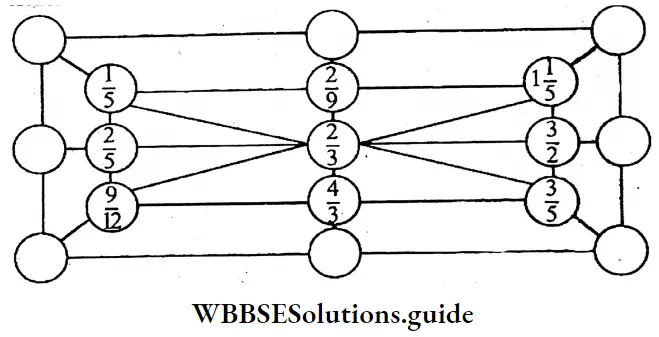
Solution:
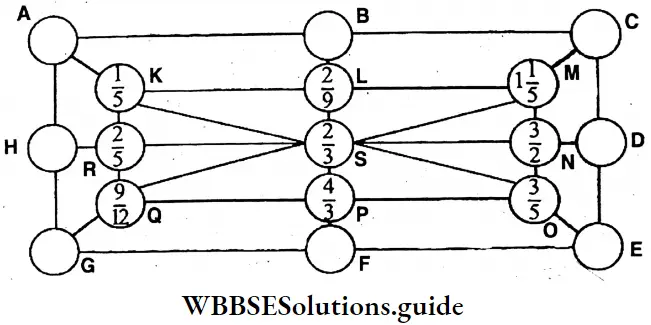
(s) is multiplied by the fraction of the angular points we get the following results (K, M, O, P).
1. sxk= \(\frac{2}{3} x \frac{1}{5}=\frac{2}{15}\)…. (A)
2. sxM = \(\frac{2}{3} \times 1 \frac{1}{5}=\frac{2}{3} \times \frac{6}{5}=\frac{4}{5}\)….(C)
3. sxO = \(\frac{2}{3} \times \frac{3}{5}=\frac{2}{3}\)…….(E)
4. sxQ = \(\frac{2}{3} \times \frac{9}{12}=\frac{1}{2}\)…..(G)
Division For Class 6
Again, \(\frac{2}{3}\) (s) is divided by the fractions of the horizontal & vertical mid¬points (R, N, and L, P) we get.
1. \(S \div R=\frac{2}{3} \div \frac{2}{5}=\frac{2}{3} \times \frac{5}{2}=\frac{5}{3}\) …..(H)
2. \(\mathrm{S} \div \mathrm{N}=\frac{2}{3} \div \frac{3}{2}=\frac{2}{3} \times \frac{2}{3}=\frac{4}{9}\)……(D)
3. \(\mathrm{S} \div \mathrm{L}=\frac{2}{3} \div \frac{2}{9}=\frac{2}{3} \times \frac{9}{2}\)….(B)
4. \(S \div P=\frac{2}{3} \div \frac{4}{3}=\frac{2}{3} \times \frac{3}{4}=\frac{1}{2}\)….(F)
